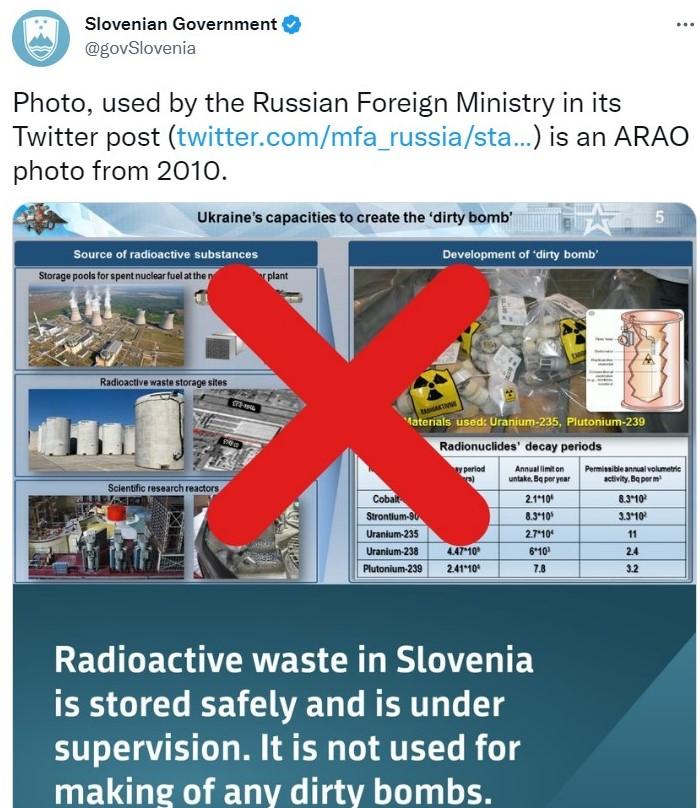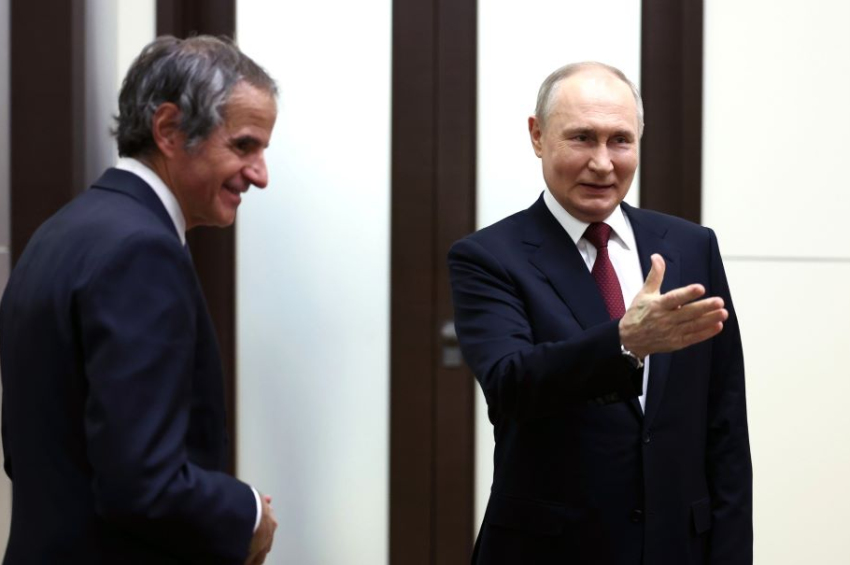[video] How many nuclear warheads does Putin actually have?
The Kremlin leader has issued a series of warnings regarding the use of nuclear missile strikes if the West continues to supply modern weaponry to Ukraine or directly engage in the war. The possibility of a nuclear escalation is also speculated in the scenario of Russian troops being defeated on the frontlines.
More recently, Foreign Minister Sergey Lavrov claimed that the government in Kiev was preparing to test "dirty bombs" (radioactive) for subsequent use against Russia, which in his opinion would justify a nuclear attack. As evidence, Moscow distributed photos of bags containing radioactive waste labeled "radioaktivno," along with an image of a nuclear research center.
The art of manipulation
In reality, the photos of the bags were published over 10 years ago, and the waste material came from Slovenia, whose government immediately accused Russian officials of perpetuating disinformation. The image from inside the center was taken in February 2021 at the Research Institute in Gatchina, near the city of St. Petersburg in northern Russia. The original image is still available on the website of Rosatom, Russia’s atomic energy agency.

Despite the Kremlin's dissemination of obvious falsehoods, in October 2022, NATO conducted military exercises simulating a conflict involving the use of nuclear weapons, in the context of the risk of a nuclear conflagration, to which the Russian Federation responded with its own exercises the very next week.

Although Vladimir Putin creates a tsunami by boasting about having the largest nuclear arsenal in the world, how many nuclear warheads does Russia actually have?
On paper
The International Arms Control and Non-Proliferation Center estimates that Russia has 5,977 nuclear warheads, of which 1,588 are in active service. Just over half of them are strategic, while the rest have tactical purposes. The launch capability consists of 68 bombers (air-launched), 11 submarines (sea-launched), and 306 ground-based missile launchers.
The Federation of American Scientists has calculated the same number of nuclear warheads in Moscow's arsenal, but specified that only 4,477 are under military control. 1,500 have been decommissioned.

Other sources report different figures, but virtually all of them state that during Putin's governance, the Russian Federation has modernized its armed forces, particularly its nuclear arsenal. These pieces of information are mainly based on statements from the Kremlin leader and images provided by the Russian Ministry of Defense.
Animation videos
The truth is that the last time Russia tested a nuclear weapon was on 24 October 1990, that is 32 years ago, during the days when the USSR was on its deathbed. Whatever Moscow has shown since then are recordings of conventional weapon tests, including archival videos and animation comics depicting new hypersonic missiles hitting targets in various parts of the planet.
The (genuine) modernization of the Russian/Soviet nuclear arsenal was halted in 1982 due to the billions of rubles poured into the war in Afghanistan, which literally killed the Soviet economy.
It is important to note that the lifespan of a Soviet-produced nuclear warhead was limited to 20 years, and keeping it beyond this term becomes dangerous. The subsequent options are limited to extending the validity "at your own risk" and wasting the nuclear material.
The third path - modernization - is unlikely, considering the country's inability to produce mobile phones or computers, instead of relying entirely on foreign components, and that the only serious occupation of politicians is stealing public funds. Why genuinely spend $12-25 billion annually on modernization and maintenance rather than give $12-25 million to propagandist-troubadours to broadcast nuclear animation and hide the REST in offshore accounts?
Technological degradation
An eloquent example is Russia's space exploration program, which has declined due to lack of investment. Although Moscow continues to send satellites into space (mostly military ones), Russian cosmonauts have started flying on American rockets, such as Elon Musk's SpaceX. The latest passenger was Anna Kikina, and the launch took place on 5 October.
Even 30 years since the collapse of the USSR, the Russian Federation continues to rely heavily on Soviet-generation rockets like "Soyuz" and "Proton," mostly launched from Kazakhstan or French Guiana. For comparison, the American rocket "Atlas" alone has 18 models spanning at least 3 generations. When it comes to launch sites, NASA has competitors from the private sector - SpaceX, Amazon, Virgin Galactic - which operate their own ports.
The Atlantic Council, a non-profit organization laboring on security issues, reported two years ago that Russia was developing "exotic" nuclear weapons, and the technical specifications provided by Moscow surpassed all known weapon systems in terms of technology, which looks incredible. For example, the "Burevestnik" missile is supposed to be able to cover "unlimited distances" without being detected, although the Russians have not bothered to prove anything.
Returning to nuclear weapons - the only area where Russia has truly succeeded is the utilization of nuclear waste, which generates substantial profits if you know who to share them with (certainly not scientists). High-level corruption is a hallmark in every field in Russia, including defense, and the war in Ukraine has exposed this aspect to its maximum.
The illusion of power
Do you remember video footage in which Russian soldiers abandoned their combat vehicles in Ukraine due to lack of fuel or ammunition? Or the scandal involving the disappearance of 1.5 million sets of uniforms and undergarments (apologies, but we can't help mentioning it again - 1.5 million!) from army depots?
On YouTube, videos have already become popular showing Russian recruits, mobilized in September-October, complaining that they are being sent to war without proper training or essential equipment. Some have rusty Kalashnikovs, others have Mosin-Nagant rifles from 1882-1891, and they all wear rubber boots produced in the 1950s-60s or incomplete medical kits.
An investigation published by The Guardian revealed that in 2015 alone, authorities filed 12,000 criminal cases related to large-scale theft of military equipment in Russia. And this happened despite Putin classifying all information regarding the offenses committed by law enforcement, defense, and security personnel.
If Putin no longer has Kalashnikovs for the men he sends to the front, why should we believe that the nuclear warheads, which are worth much more than uniforms, have remained intact in storage? Or, where are the hypersonic missiles that Putin showcased (in animation videos) to the whole world?
More to read:
Bill Clinton regrets for persuading Ukrainians to give up their nuclear weapons
However, our questioning does not end here. Suppose that the warheads are fine, then are the transport projectiles fully functional too? Can they be launched without the risk of exploding during ejection? And most importantly, how will the Russians be able to move these weapons out of bunkers without being detected by NATO? US President Joe Biden has assured that the allies are closely monitoring any movement around missile silos and locations where Russian nuclear warheads are stored, and they will react before Moscow gets to prepare for an attack.
Furthermore, there is no reason to believe that the dictator's entourage will obey his suicidal orders. They all have families, children studying abroad, and hidden wealth in the West, and they all want to live, including Putin.
The Russian invasion of Ukraine has revealed the true state of the aggressor's forces and, by default, the true extent of corruption in the Russian Federation. Russian nuclear weapons should be as pathetic as the army itself, as the automobile industry, space exploration program, medicine, science, and other fields in Russia — a facade covering internal emptiness, similar to the famous "Potemkin villages."
The nature of authoritarian kleptocratic regimes is to steal, not to develop, and this is where most of Vladimir Putin's and his elite’s achievements are.
Let's not forget that the lifespan of a plutonium-239 nuclear warhead is 18 years, and that of a uranium-235 warhead is 30 years. Plutonium production for weapons in the Russian Federation ceased in 1991, and uranium for military purposes in 1990. Thus, Russia should have been without plutonium warheads for 14 years already, and without uranium warheads for at least three years.
The bear has proven to be a fox that tells everyone stories about its mighty claws but prefers to prey only on helpless chickens. In a first confrontation with a rooster, it runs away, warning about its "magic" claws, which have gone blunt in the meantime.
Instead of an epilogue: Don't!
Whether Russia still has nuclear weapons and whether they are still functional is a billion-dollar question. For the purpose of causing chaos, a single, even primitive bomb would be sufficient, and – in order to bring Ukraine to its knees and scare the West - the Kremlin might resort to this desperate but ineffective gesture.
Under these circumstances, Putin risks seeing his armed forces completely annihilated in a matter of hours, with no chance of pressing the red button a second time, to quote NATO's response. On his behalf, Biden promised, however, that the missiles will explode on Russian soil, even before getting launched.
***
Dear reader, thanks for visiting our website. If you have a minute, please donate to this small publication via Banca Transilvania (Romania): euro account RO50BTRLEURCRT0490900501, for Rudeana SRL. Any amount is welcome. Thanks.







